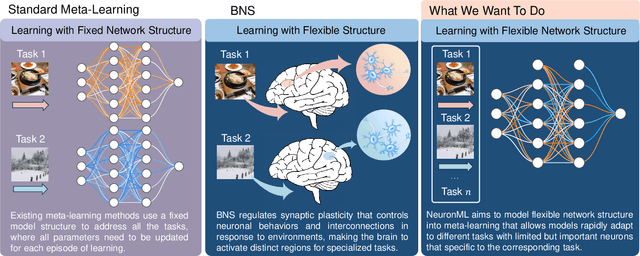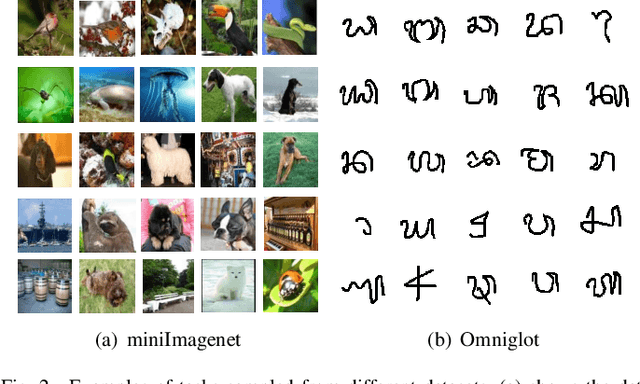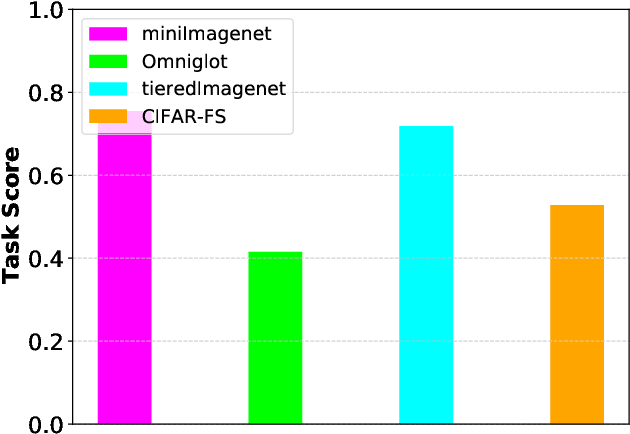Jingyao Wang
Enhancing Time Series Forecasting via Logic-Inspired Regularization
Mar 10, 2025Abstract:Time series forecasting (TSF) plays a crucial role in many applications. Transformer-based methods are one of the mainstream techniques for TSF. Existing methods treat all token dependencies equally. However, we find that the effectiveness of token dependencies varies across different forecasting scenarios, and existing methods ignore these differences, which affects their performance. This raises two issues: (1) What are effective token dependencies? (2) How can we learn effective dependencies? From a logical perspective, we align Transformer-based TSF methods with the logical framework and define effective token dependencies as those that ensure the tokens as atomic formulas (Issue 1). We then align the learning process of Transformer methods with the process of obtaining atomic formulas in logic, which inspires us to design a method for learning these effective dependencies (Issue 2). Specifically, we propose Attention Logic Regularization (Attn-L-Reg), a plug-and-play method that guides the model to use fewer but more effective dependencies by making the attention map sparse, thereby ensuring the tokens as atomic formulas and improving prediction performance. Extensive experiments and theoretical analysis confirm the effectiveness of Attn-L-Reg.
Spatio-Temporal Fuzzy-oriented Multi-Modal Meta-Learning for Fine-grained Emotion Recognition
Dec 18, 2024Abstract:Fine-grained emotion recognition (FER) plays a vital role in various fields, such as disease diagnosis, personalized recommendations, and multimedia mining. However, existing FER methods face three key challenges in real-world applications: (i) they rely on large amounts of continuously annotated data to ensure accuracy since emotions are complex and ambiguous in reality, which is costly and time-consuming; (ii) they cannot capture the temporal heterogeneity caused by changing emotion patterns, because they usually assume that the temporal correlation within sampling periods is the same; (iii) they do not consider the spatial heterogeneity of different FER scenarios, that is, the distribution of emotion information in different data may have bias or interference. To address these challenges, we propose a Spatio-Temporal Fuzzy-oriented Multi-modal Meta-learning framework (ST-F2M). Specifically, ST-F2M first divides the multi-modal videos into multiple views, and each view corresponds to one modality of one emotion. Multiple randomly selected views for the same emotion form a meta-training task. Next, ST-F2M uses an integrated module with spatial and temporal convolutions to encode the data of each task, reflecting the spatial and temporal heterogeneity. Then it adds fuzzy semantic information to each task based on generalized fuzzy rules, which helps handle the complexity and ambiguity of emotions. Finally, ST-F2M learns emotion-related general meta-knowledge through meta-recurrent neural networks to achieve fast and robust fine-grained emotion recognition. Extensive experiments show that ST-F2M outperforms various state-of-the-art methods in terms of accuracy and model efficiency. In addition, we construct ablation studies and further analysis to explore why ST-F2M performs well.
DiffDesign: Controllable Diffusion with Meta Prior for Efficient Interior Design Generation
Nov 25, 2024Abstract:Interior design is a complex and creative discipline involving aesthetics, functionality, ergonomics, and materials science. Effective solutions must meet diverse requirements, typically producing multiple deliverables such as renderings and design drawings from various perspectives. Consequently, interior design processes are often inefficient and demand significant creativity. With advances in machine learning, generative models have emerged as a promising means of improving efficiency by creating designs from text descriptions or sketches. However, few generative works focus on interior design, leading to substantial discrepancies between outputs and practical needs, such as differences in size, spatial scope, and the lack of controllable generation quality. To address these challenges, we propose DiffDesign, a controllable diffusion model with meta priors for efficient interior design generation. Specifically, we utilize the generative priors of a 2D diffusion model pre-trained on a large image dataset as our rendering backbone. We further guide the denoising process by disentangling cross-attention control over design attributes, such as appearance, pose, and size, and introduce an optimal transfer-based alignment module to enforce view consistency. Simultaneously, we construct an interior design-specific dataset, DesignHelper, consisting of over 400 solutions across more than 15 spatial types and 15 design styles. This dataset helps fine-tune DiffDesign. Extensive experiments conducted on various benchmark datasets demonstrate the effectiveness and robustness of DiffDesign.
Neuromodulated Meta-Learning
Nov 11, 2024



Abstract:Humans excel at adapting perceptions and actions to diverse environments, enabling efficient interaction with the external world. This adaptive capability relies on the biological nervous system (BNS), which activates different brain regions for distinct tasks. Meta-learning similarly trains machines to handle multiple tasks but relies on a fixed network structure, not as flexible as BNS. To investigate the role of flexible network structure (FNS) in meta-learning, we conduct extensive empirical and theoretical analyses, finding that model performance is tied to structure, with no universally optimal pattern across tasks. This reveals the crucial role of FNS in meta-learning, ensuring meta-learning to generate the optimal structure for each task, thereby maximizing the performance and learning efficiency of meta-learning. Motivated by this insight, we propose to define, measure, and model FNS in meta-learning. First, we define that an effective FNS should possess frugality, plasticity, and sensitivity. Then, to quantify FNS in practice, we present three measurements for these properties, collectively forming the \emph{structure constraint} with theoretical supports. Building on this, we finally propose Neuromodulated Meta-Learning (NeuronML) to model FNS in meta-learning. It utilizes bi-level optimization to update both weights and structure with the structure constraint. Extensive theoretical and empirical evaluations demonstrate the effectiveness of NeuronML on various tasks. Code is publicly available at \href{https://github.com/WangJingyao07/NeuronML}{https://github.com/WangJingyao07/NeuronML}.
Rethinking Meta-Learning from a Learning Lens
Sep 13, 2024Abstract:Meta-learning has emerged as a powerful approach for leveraging knowledge from previous tasks to solve new tasks. The mainstream methods focus on training a well-generalized model initialization, which is then adapted to different tasks with limited data and updates. However, it pushes the model overfitting on the training tasks. Previous methods mainly attributed this to the lack of data and used augmentations to address this issue, but they were limited by sufficient training and effective augmentation strategies. In this work, we focus on the more fundamental ``learning to learn'' strategy of meta-learning to explore what causes errors and how to eliminate these errors without changing the environment. Specifically, we first rethink the algorithmic procedure of meta-learning from a ``learning'' lens. Through theoretical and empirical analyses, we find that (i) this paradigm faces the risk of both overfitting and underfitting and (ii) the model adapted to different tasks promote each other where the effect is stronger if the tasks are more similar. Based on this insight, we propose using task relations to calibrate the optimization process of meta-learning and propose a plug-and-play method called Task Relation Learner (TRLearner) to achieve this goal. Specifically, it first obtains task relation matrices from the extracted task-specific meta-data. Then, it uses the obtained matrices with relation-aware consistency regularization to guide optimization. Extensive theoretical and empirical analyses demonstrate the effectiveness of TRLearner.
Image-based Freeform Handwriting Authentication with Energy-oriented Self-Supervised Learning
Aug 19, 2024Abstract:Freeform handwriting authentication verifies a person's identity from their writing style and habits in messy handwriting data. This technique has gained widespread attention in recent years as a valuable tool for various fields, e.g., fraud prevention and cultural heritage protection. However, it still remains a challenging task in reality due to three reasons: (i) severe damage, (ii) complex high-dimensional features, and (iii) lack of supervision. To address these issues, we propose SherlockNet, an energy-oriented two-branch contrastive self-supervised learning framework for robust and fast freeform handwriting authentication. It consists of four stages: (i) pre-processing: converting manuscripts into energy distributions using a novel plug-and-play energy-oriented operator to eliminate the influence of noise; (ii) generalized pre-training: learning general representation through two-branch momentum-based adaptive contrastive learning with the energy distributions, which handles the high-dimensional features and spatial dependencies of handwriting; (iii) personalized fine-tuning: calibrating the learned knowledge using a small amount of labeled data from downstream tasks; and (iv) practical application: identifying individual handwriting from scrambled, missing, or forged data efficiently and conveniently. Considering the practicality, we construct EN-HA, a novel dataset that simulates data forgery and severe damage in real applications. Finally, we conduct extensive experiments on six benchmark datasets including our EN-HA, and the results prove the robustness and efficiency of SherlockNet.
On the Causal Sufficiency and Necessity of Multi-Modal Representation Learning
Jul 19, 2024Abstract:An effective paradigm of multi-modal learning (MML) is to learn unified representations among modalities. From a causal perspective, constraining the consistency between different modalities can mine causal representations that convey primary events. However, such simple consistency may face the risk of learning insufficient or unnecessary information: a necessary but insufficient cause is invariant across modalities but may not have the required accuracy; a sufficient but unnecessary cause tends to adapt well to specific modalities but may be hard to adapt to new data. To address this issue, in this paper, we aim to learn representations that are both causal sufficient and necessary, i.e., Causal Complete Cause ($C^3$), for MML. Firstly, we define the concept of $C^3$ for MML, which reflects the probability of being causal sufficiency and necessity. We also propose the identifiability and measurement of $C^3$, i.e., $C^3$ risk, to ensure calculating the learned representations' $C^3$ scores in practice. Then, we theoretically prove the effectiveness of $C^3$ risk by establishing the performance guarantee of MML with a tight generalization bound. Based on these theoretical results, we propose a plug-and-play method, namely Causal Complete Cause Regularization ($C^3$R), to learn causal complete representations by constraining the $C^3$ risk bound. Extensive experiments conducted on various benchmark datasets empirically demonstrate the effectiveness of $C^3$R.
Explicitly Modeling Generality into Self-Supervised Learning
May 02, 2024Abstract:The goal of generality in machine learning is to achieve excellent performance on various unseen tasks and domains. Recently, self-supervised learning (SSL) has been regarded as an effective method to achieve this goal. It can learn high-quality representations from unlabeled data and achieve promising empirical performance on multiple downstream tasks. Existing SSL methods mainly constrain generality from two aspects: (i) large-scale training data, and (ii) learning task-level shared knowledge. However, these methods lack explicit modeling of the SSL generality in the learning objective, and the theoretical understanding of SSL's generality remains limited. This may cause SSL models to overfit in data-scarce situations and generalize poorly in the real world, making it difficult to achieve true generality. To address these issues, we provide a theoretical definition of generality in SSL and define a $\sigma$-measurement to help quantify it. Based on this insight, we explicitly model generality into self-supervised learning and further propose a novel SSL framework, called GeSSL. It introduces a self-motivated target based on $\sigma$-measurement, which enables the model to find the optimal update direction towards generality. Extensive theoretical and empirical evaluations demonstrate the superior performance of the proposed GeSSL.
Meta-Auxiliary Learning for Micro-Expression Recognition
Apr 18, 2024Abstract:Micro-expressions (MEs) are involuntary movements revealing people's hidden feelings, which has attracted numerous interests for its objectivity in emotion detection. However, despite its wide applications in various scenarios, micro-expression recognition (MER) remains a challenging problem in real life due to three reasons, including (i) data-level: lack of data and imbalanced classes, (ii) feature-level: subtle, rapid changing, and complex features of MEs, and (iii) decision-making-level: impact of individual differences. To address these issues, we propose a dual-branch meta-auxiliary learning method, called LightmanNet, for fast and robust micro-expression recognition. Specifically, LightmanNet learns general MER knowledge from limited data through a dual-branch bi-level optimization process: (i) In the first level, it obtains task-specific MER knowledge by learning in two branches, where the first branch is for learning MER features via primary MER tasks, while the other branch is for guiding the model obtain discriminative features via auxiliary tasks, i.e., image alignment between micro-expressions and macro-expressions since their resemblance in both spatial and temporal behavioral patterns. The two branches of learning jointly constrain the model of learning meaningful task-specific MER knowledge while avoiding learning noise or superficial connections between MEs and emotions that may damage its generalization ability. (ii) In the second level, LightmanNet further refines the learned task-specific knowledge, improving model generalization and efficiency. Extensive experiments on various benchmark datasets demonstrate the superior robustness and efficiency of LightmanNet.
Intriguing Properties of Positional Encoding in Time Series Forecasting
Apr 16, 2024Abstract:Transformer-based methods have made significant progress in time series forecasting (TSF). They primarily handle two types of tokens, i.e., temporal tokens that contain all variables of the same timestamp, and variable tokens that contain all input time points for a specific variable. Transformer-based methods rely on positional encoding (PE) to mark tokens' positions, facilitating the model to perceive the correlation between tokens. However, in TSF, research on PE remains insufficient. To address this gap, we conduct experiments and uncover intriguing properties of existing PEs in TSF: (i) The positional information injected by PEs diminishes as the network depth increases; (ii) Enhancing positional information in deep networks is advantageous for improving the model's performance; (iii) PE based on the similarity between tokens can improve the model's performance. Motivated by these findings, we introduce two new PEs: Temporal Position Encoding (T-PE) for temporal tokens and Variable Positional Encoding (V-PE) for variable tokens. Both T-PE and V-PE incorporate geometric PE based on tokens' positions and semantic PE based on the similarity between tokens but using different calculations. To leverage both the PEs, we design a Transformer-based dual-branch framework named T2B-PE. It first calculates temporal tokens' correlation and variable tokens' correlation respectively and then fuses the dual-branch features through the gated unit. Extensive experiments demonstrate the superior robustness and effectiveness of T2B-PE. The code is available at: \href{https://github.com/jlu-phyComputer/T2B-PE}{https://github.com/jlu-phyComputer/T2B-PE}.
 Add to Chrome
Add to Chrome Add to Firefox
Add to Firefox Add to Edge
Add to Edge